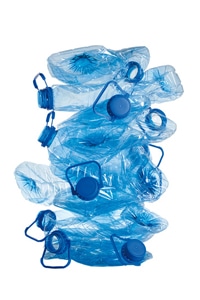
July 4, 2016
Water Bottles, Water Bottles, Everywhere
By Michael D. Shaw
With apologies to Samuel Taylor Coleridge, and his epic “The Rime of the Ancient Mariner.”
Water, water, every where,
And all the boards did shrink;
Water, water, every where,
Nor any drop to drink.
Ironically, these days—with our focus on hydration and the omnipresence of bottled water—the bottles themselves have become a problem. In many cases, they can be recycled, but industry estimates suggest that fewer than one-third of them actually are recycled. To mix a metaphor or two, and in keeping with the poem, might we argue that the bottles have become the proverbial albatross around hydration’s neck?
No doubt, there are applications—including getting pure water to people in remote areas, or for emergencies—in which bottled water is a perfect fit. But many others, including use at home, cry out for more environmentally-responsible solutions.
One quite common alternative to bottled water involves the use of in-line filtration of the tap water line, for input into the refrigerator, thus delivering chilled, purified water. Such filters employ activated charcoal, and are effective in removing many types of contaminants.
Strictly speaking, charcoal is an impure form of graphitic carbon, obtained as a residue when carbonaceous material is partially burned, or heated with limited access of air. Prior to so-called “activation,” which is accomplished via a variety of processes (usually encompassing heat-treating), charcoal has a porosity and internal surface in the range of 10-15 square meters/gram.
Upon being activated, the surface area increases dramatically to 1000-1200 square meters/gram. The activation process creates a labyrinth of pores, with pore sizes ranging from less than four nanometers (micro-pores) to greater than 500 nm (macro-pores).
As it happens, activated charcoal derived from coconut shells is highly prized, since 85-90 percent of its surface area consists of pores in the micro range. The micro-pore size ideally matches the size of potential drinking water contaminant molecules—for optimum removal. Moreover, this predominance of micro-pores imparts exceptional hardness and mechanical strength to the material. And, coconuts are a renewable source of charcoal.
Which brings us to KOR Water, Inc., a design-driven hydration company, based in Aliso Viejo, CA. KOR Water is perhaps best known for its Nava filtering water bottle, referred to in early press releases as a “bottled water killer.” Less than three years following Nava coming on the market, KOR has just introduced Water Fall, the first “pour-over” water filtration product for the home.
Water Fall solves the limitations inherent in filtered water pitchers. According to KOR Water Founder and CEO Eric Barnes…
“Filtered pitchers are an ‘all-in-one’ gizmo where the pitcher, the water reservoir, and the filter are all crammed together. The problem is that after you filter the water, the filter and reservoir stay in the pitcher, robbing half of the space of the pitcher. Second, filtered pitchers are linear in that you can only filter one pitcher at a time. You have to empty the pitcher before you can fill it again to filter more water. We’d argue that current pitchers are also unsightly and cumbersome to carry.”
“Water Fall separates the filter from the carafe, and using a technique borrowed from pour-over coffee, allows you to ‘craft brew’ water using an all-natural, coconut-based filter. It’s really a subtle innovation that has a big payoff. You can serve simple chilled water, infused-with-fruit water…you name it. The filter lasts four months (twice as long as other pitchers on the market) and removes both chlorine and chloramines.”
Good stuff! Pivoting back to our Ancient Mariner, and recalling what finally happened to that albatross: Following the Mariner’s vision of beautiful creatures…
The Albatross fell off, and sank
Like lead into the sea.
Alas, our literary pretenses have completely broken down. We can hardly fling the water bottles into the sea, can we?
